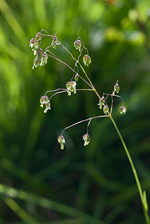|
||||||
|
BRIZA. Quaking-grasses. [Poaceae] |
|
|
Only one species of Briza is native in Britain - Greater Quaking-grass, (B. maxima). Lesser Quaking-grass (B. minor), Quaking-grass (B. media) and B. humilis have been introduced. Seven British miners are recorded on Briza. Nearly 100 British miners or possible miners are recorded on grasses in Britain. A key to the European miners recorded on Briza is provided in Bladmineerders van Europa. It is recommended that adults of all miners on grasses be reared to be certain of their identity. |
|
Key for the identification of the known mines of British |
Note: Diptera larvae may live in a corridor mine, a corridor-blotch mine, or a blotch mine, but never in a case, a rolled or folded leaf, a tentiform mine or sandwiched between two more or less circular leaf sections in later instars. Pupation never in a cocoon. All mining Diptera larvae are leg-less maggots without a head capsule (see examples). They never have thoracic or abdominal legs. They do not have chewing mouthparts, although they do have a characteristic cephalo-pharyngeal skeleton (see examples), usually visible internally through the body wall. The larvae lie on their sides within the mine and use their pick-like mouthparts to feed on plant tissue. In some corridor miners frass may lie in two rows on alternate sides of the mine. In order to vacate the mine the fully grown larva cuts an exit slit, which is usually semi-circular (see Liriomyza huidobrensis video). The pupa is formed within the hardened last larval skin or puparium and as a result sheaths enclosing head appendages, wings and legs are not visible externally (see examples). See Key to non-Diptera. |
1a> Leaf-miner: Long upper-surface corridor usually containing several larvae that graze shoulder to shoulder from the leaf tip downwards. Pupation outside the mine. Mines and larvae are indistinguishable from those of A. nigrella. |
|
Agromyza mobilis Meigen, 1830 [Diptera: Agromyzidae]. |
1b > Leaf-miner: Larval leaf-mine starts as a narrow channel running towards apex of leaf but later develops into a broad blotch running downwards. Frass largely diffused, giving the mine a characteristic greenish appearance. Pupation external (Spencer, 1976: 126). Corridor, usually several in one leaf, running from close to the leaf base up to near the tip, then reversing direction and widening, resulting in one communal mine in which the larvae descend in a common front. Frass somewhat deliquescent, mine therefore strikingly green. Pupation outside the mine. Neither mine nor larva distinguishable from those of mobilis. Puparium reddish brown |
|
Agromyza nigrella (Rondani, 1875) [Diptera: Agromyzidae]. |
1c > Leaf-miner: Broad elongated mine; the form is dependent of the leaf form of the host plant. Frass green. Usually a number of larvae together in a mine. Pupation in the mine. |
|
Cerodontha incisa (Meigen, 1830) [Diptera: Agromyzidae]. |
1d > Leaf-miner: Long, narrow, whitish mine. Pupation internal (Spencer, 1976: 453); anterior spiracles projecting through the epidermis. Whitish, upper-surface, rather narrow corridor with comparatively large frass grains that are laying further apart than their diameter. Pupation within the mine. The anterior spiracles of the orange-brown puparium penetrate the epidermis. |
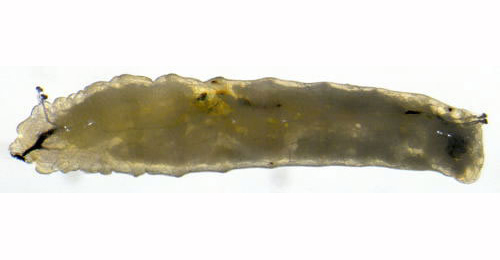 Chromatomyia nigra larva, lateral Image: © Willem Ellis (Bladmineerders van Europa) |
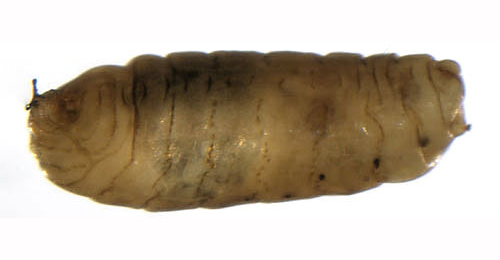 Chromatomyia nigra pupa, lateral Image: © Willem Ellis (Bladmineerders van Europa) |
|
Chromatomyia nigra (Meigen, 1830) [Diptera: Agromyzidae]. |
1e > Leaf-miner: A narrow whitish linear mine, running down the leaf from the apex, with frass in two rows of separate grains. Pupation external (Spencer, 1976: 246). Narrow corridor from start to end, whitish, uppper- or lower-surface, genarally running downwards. Mine often along the leaf margin. Frass in distict grains of regular size, alternating along the sides of the corridor. Pupation outside the mine. |
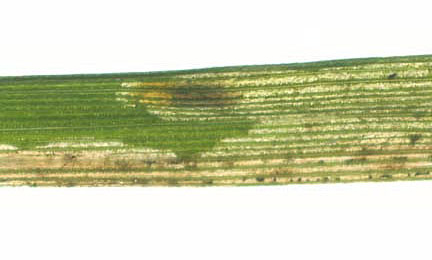 Mine of Liriomyza flaveola on Festuca gigantea Image: © Willis Ellis (Bladmineerders van Europa) |
|
Liriomyza flaveola (Fallén, 1823) [Diptera: Agromyzidae]. |
| 1f > Leaf-miner: Irregular mine, locally shallow, elsewhere much deeper, giving it a mottled appearance. In broadleaved plants the mine often begins as a blotch with stellate extensions, but sometimes as a very fine, shallow corridor. In grasses the mine often begins in the leaf sheath. The frass is very fine-grained, initially scattered, later in aggregates. The egg is deposited on the plant surface, and the empty egg shell remains visible. But the larvae are able to leave their mine and restart elsewhere, thus mines without an egg shell can be found as well. The larva also leaves the mine before pupation. Pupation takes place in a newly made, small, blotch mine without frass; this mine may be made in another plant (species). |
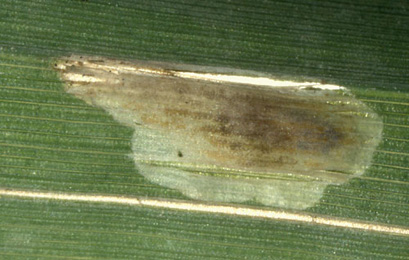 Mine of Hydrellia griseola on Glyceria fluitans Image: © Willem Ellis (Bladmineerders van Europa) |
|
Hydrellia griseola (Fallén, 1813) [Diptera: Ephydridae]. |
Key for the identification of the known mines of British |
1 > Seed-feeder, leaf-miner and case-bearer: Initially it feeds on the seeds of thyme and then uses the seedhead as a case. It overwinters in this case and starts feeding again in March on grass spp. It then makes a case from the mined blade of grass. The larva initially feeds on the seeds of thyme, feeding within a floret and using this as its case. After overwintering, it changes foodplants to grass, and eventually forms an elongated case from two grass blade portions sewn together. The larva begins its life by eating out the ripe fruit of a thyme floret. The emptied and dried calyx functions as its first case, in which it hibernates. After hibernation the larva switches to grasses, initially in its original thyme case. Later a new case is made out of a mined grass leaf. This final case is about 11 mm long, two-valved, straw-coloured, has a mouth angle of 25°, and bears a striking resemblance to a grass spikelet. |
|
Coleophora lixella Zeller, 1849 [Lepidoptera: Coleophoridae] |
| Last updated 01-Jul-2019 Brian Pitkin | ||

